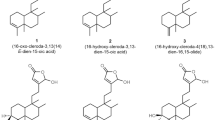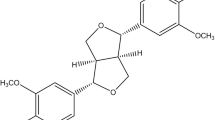Abstract
Hepatocellular carcinoma is a major example for inflammatory-associated cancer. cucurbitacins are natural triterpenoids known for their potent anticancer and anti-inflammatory activities. Recent studies showed that cucurbitacins protect the HepG2 cell lines against carbon tetrachloride-induced toxicity, however the mechanism is unknown. A molecular docking study coupled with in vitro biological assays were conducted to test the hepatoprotective effect of cucurbitacin on the inhibition of potential inflammatory factors. The effect of cucurbitacins on the activation of NF-kB pathway was analyzed using in cell-based NF-kB immunoassay. Enzyme-linked immunosorbent assays revealed the potential of Cuc D and dihydro cucurbitacin D to prevent the production of tumor necrosis factor-alpha and interleukin-6 from HSC-T6 cells. Thus, Cuc D and dihydro cucurbitacin D could have hepatoprotective effects on the activated rat HSC-T6 cells due to inhibition of the production of tumor necrosis factor-alpha and interleukin-6 through NF-kB pathway. In-silico molecular modeling data revealed potential cucurbitacin analogs with higher binding affinity to the hydrophobic pocket of NF-kB and IKKβ compared to standard IKK inhibitor (PS-1145).






Similar content being viewed by others
References
Adewusi E, Afolayan A (2010) Review of natural products with Hepatoprotective activity. J Med Plants Res 4:1318–1334
Ahmed MS, El-Senduny F, Taylor J, Halaweish F (2017) Biological screening of cucurbitacin inspired estrone analogs targeting mitogen activated protein kinase (MAPK) pathway. Chem Biol Drug Des, doi:10.1111/cbdd.12963. [Epub ahead of print]
Ahmed MS, Halaweish FT (2014) Cucurbitacins: potential candidates targeting mitogen-activated protein kinase pathway for treatment of melanoma. J Enzyme Inhib Med Chem 29:162–167
Ahmed MS, Kopel L, Halaweish F (2014) Structural optimization and biological screening of a steroidal scaffold possessing cucurbitacin-like functionalities as B-raf inhibitors. ChemMedChem 9:1361–1367
Alghasham A (2013) Cucurbitacins - a promising target for cancer therapy. Int J Med Health Sci 7:77–89
Bartalis J, Halaweish F (2011) In vitro and QSAR studies of cucurbitacins on HepG2 and HSC-T6 liver cell lines. Bioorg Med Chem 19:2757–2766
Berasain C, Castillo J, Perugorria MJ, Latasa MU, Prieto J, Avila MA (2009) Inflammation and liver cancer: new molecular links. Ann N Y Acad Sci 1155:206–221
Chen JC, Chiu MH, Nie RL, Cordell GA, Qiu SX (2005) Cucurbitacins and cucurbitane glycosides: structures and biological activities. Nat Prod Rep 22:386–399
Covert M, Leung H, Gaston E, Baltimore D (2005) Achieving stability of lipopolysaccharide-induced NF-kB activation. Science 309:1854–1857
Dhiman K, Gupta A, Sharma D, Gill N, Goyal A (2012) A review on the medicinally important plants of the family cucurbitaceae. Asian J Clin Nutr 4:16–26
Escandell J, Recio M, Máñez S, Giner R, Cerdá-Nicolás M, Ríos J (2007) Cucurbitacin R reduces the inflammation and bone damage associated with adjuvant arthritis in lewis rats by suppression of tumor necrosis factor-alpha in T lymphocytes and macrophages. J Pharmacol Exp Ther 320:581–590
Hawkins PCD, Skillman AG, Warren GL, Ellingson BA, Stahl MT (2010) Conformer generation with OMEGA: algorithm and validation using high quality structures from the protein databank and cambridge structural database. J Chem Inf Model 50:572–584
Jayaprakasam B, Seeram NP, Nair MG (2003) Anticancer and antiinflammatory activities of cucurbitacins from cucurbita andreana. Cancer lett 189:11–16
Jia Q, Cheng W, Yue Y, Hu Y, Zhang J, Pan X, Xu Z, Zhang P (2015) Cucurbitacin E inhibits TNF-α-induced inflammatory cytokine production in human synoviocyte MH7A cells via suppression of PI3K/Akt/NF-κB pathways. Int Immunopharmacol 29:884–890
Jin R, Jin X, Dat N, Lee J (2011) Cucurbitacin B suppresses the transactivation activity of RelA/p65. J Cell Biochem 112:1643–1650
Karin M, Delhase M (2000) The IKB kinase (IKK) and NF-kB : key elements of proinflammatory signalling. Semin Immunol 12:85–98
Maeda S, Kamata H, Luo JL, Leffert H, Karin M (2005) IKKbeta couples hepatocyte death to cytokine-driven compensatory proliferation that promotes chemical hepatocarcinogenesis. Cell 121:977–990
Mcgann M (2011) FRED pose prediction and virtual screening accuracy. J Chem Inf Model 5:578–596
Mühlbauer M, Weiss T, Thasler W, Gelbmann W, Schnabl B, Schölmerich J, Hellerbrand C (2004) LPS-mediated NFkappaB activation varies between activated human hepatic stellate cells from different donors. Biochem Biophys Res Commun 325:191–197
Nakagawa H, Maeda S, Yoshida H, Tateishi R, Masuzaki R, Ohki T, Hayakawa Y, Kinoshita H, Yamakado M, Kato N, Shiina S, Omata M (2009) Serum IL-6 Levels and the risk for hepatocarcinogenesis in chronic hepatitis c patients: an analysis based on gender differences. Int J Cancer 125:2264–2269
Park C, Lim H, Han K, Baek S, Sohn O, Lee W, Kim Y, Yun H, Baek K (2004) Inhibition of nitric oxide generation by 23, 24- dihydrocucurbitacin D in mouse peritoneal macrophages. J Pharmacol Exp Ther 309:705–710
Popa C, Netea MG, van Riel PL, van der Meer JW, Stalenhoef AF (2007) The role of TNF-alpha in chronic inflammatory conditions, intermediary metabolism, and cardiovascular risk. J Lipid Res 48:751–762
Rosenfeld M, Prichard L, Shiojiri N, Fausto N (2000) Prevention of hepatic apoptosis and embryonic lethality in RelA/TNFR-1 double knockout mice. Am J Pathol 156:997–1007
Acknowledgements
The authors would like to thank the Libyan ministry of higher education for funding this work, OpenEye® molecular modeling software for supporting an academic license, and Dr. Friedman (Mount. Sinai Hospital, NY) for providing the HSC-T6 cell lines. This work was supported by the Libyan ministry of higher education.
Author information
Authors and Affiliations
Corresponding author
Ethics declarations
Conflict of interest
The authors declare that they have no competing interests.
Rights and permissions
About this article
Cite this article
Arjaibi, H.M., Ahmed, M.S. & Halaweish, F.T. Mechanistic investigation of hepato-protective potential for cucurbitacins. Med Chem Res 26, 1567–1573 (2017). https://doi.org/10.1007/s00044-017-1872-3
Received:
Accepted:
Published:
Issue Date:
DOI: https://doi.org/10.1007/s00044-017-1872-3




